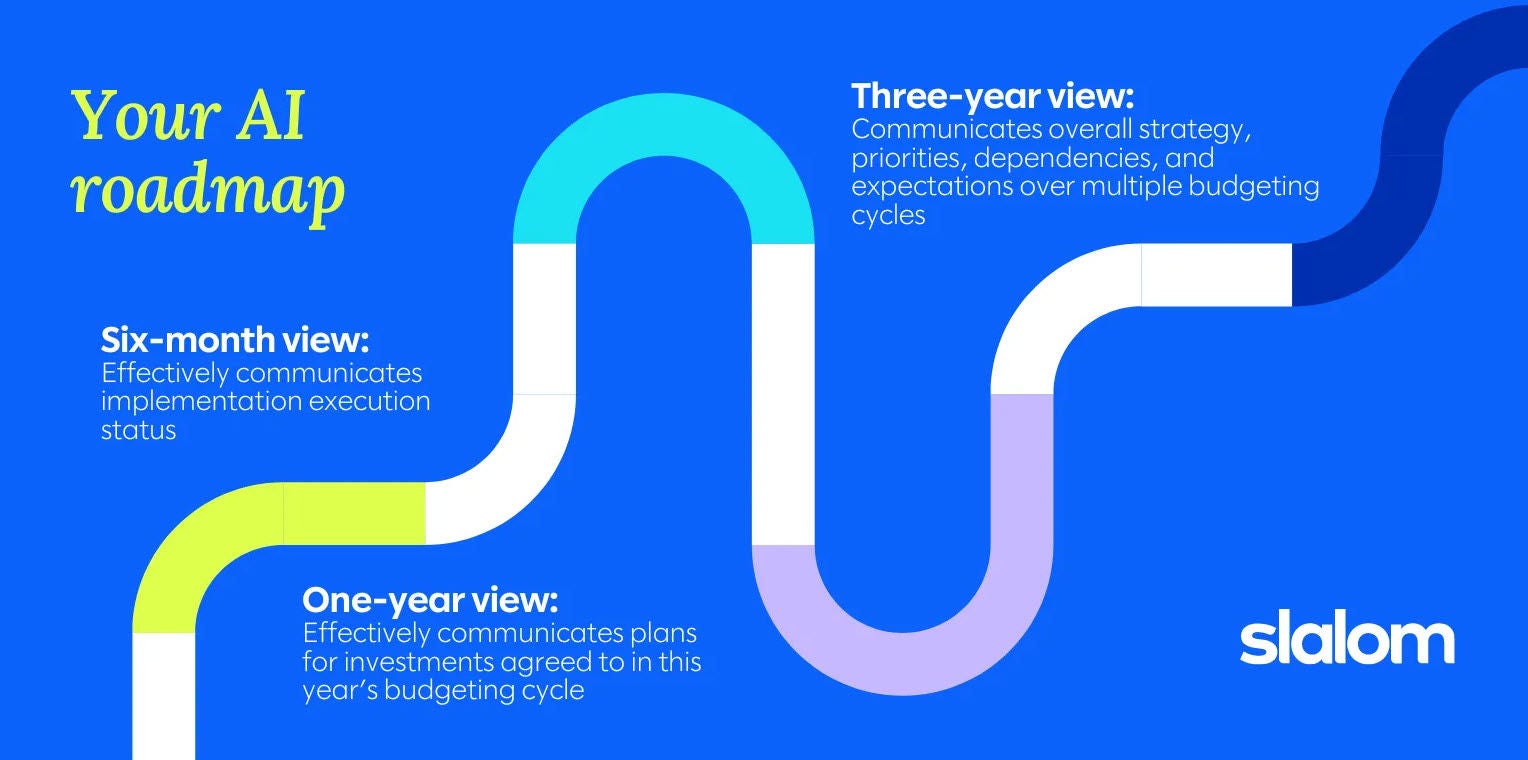Six critical success factors to realize AI potential

The advertised benefits of artificial intelligence and the unprecedented pace of change is deservedly driving substantial attention in boardrooms throughout the globe.
However, with many organizations still in the pilot stages of their AI investments, it’s unlikely that they'll realize their expected benefit of AI within the next three years. The performance history of organizations undertaking transformations when innovative technologies are introduced is well-documented in works like “Gartner Hype Cycle” by Gartner and Crossing the Chasm by Geoffrey A. Moore.
These observations not only offer forward-looking insights about typical maturity phases and timing of ingesting new capabilities, but also provide warning signals about the inevitable “trough of disillusionment” that reliably follows phases of high exuberance. AI is now reaching the peak of its hype cycle crescendo, signaling that the realized value will be lower and slower than headlines suggest in the near term.
This article outlines six areas of focus—or critical success factors (CSFs)—likely to have the biggest impact on bridging the gap between the expected and realized value of AI. In this context, CSFs are high-level, action-based goals that are vital to realizing the expected value of AI investments. The emphasis on “realize” and “expected” is important to underscore that the gap may be closed through a combination of realizing value sooner and establishing more realistic expectations for a given period.
The six CSFs are:
- Put people first
- Anchor on value
- Challenge operating models
- Establish guardrails
- Align on a roadmap
- Evolve services and information foundations for AI
These CSF’s normally carry broad dependencies, ambiguity, and are usually riddled by diverse opinions that can quickly lead to a stalemate among leadership teams. We often hear teams describe this as “we are stuck.” Teams become frustrated by their inability to align across silos and revert to executing on the current operating model while making little progress on implementing change.
Below are some pragmatic ways to establish momentum and sustainably deliver on each of the CSFs.

Put people first
People-first is not a slogan; it’s the single most important component to drive sustainable change and realize human productivity benefits that can be enabled by AI. AI refers to the ability of machines to perform tasks historically associated with humans. Inherent in AI use is establishing what people should do and what computers can do, and this requires a people-first approach.
Organizations often deploy AI technologies based on a vague notion of what’s required to drive productivity gains of 20–60%, highlighted by sources like the World Economic Forum and GitHub.com. This urgency for companies to adopt AI due to its potent capabilities and the fast pace of societal change often results in a lack of strategy for integrating these technologies into daily workflows.
This lack of direction can lead to mismatches in staffing, processes, and technology investments, which may exceed the actual productivity improvements creating a value realization gap. To bridge this gap, a people-first strategy that actively involves employees in AI integration is crucial. However, implementing this approach effectively, especially in large organizations, remains a significant challenge.
We offer three immediate actions to start building a solid foundation:
1. Assign an AI lead
AI implementation will affect the organization for years to come and someone needs to own navigating that change. This role will lead the organization to address concerns like cultural shifts, incentives, evolving job descriptions, skills readiness, and work locations. The leader’s current role and title are less important than choosing someone that genuinely carries the people first mindset and has the executive influence to effect meaningful change. Adding a new role to the executive staff can also have advantages in being able to establish cross-functional scope, to dedicate the time required to succeed, and to bring new perspectives to the team.
2. Align on scope
Bring the leadership team together to align on the purpose and scope of deploying AI. Delivering on this year’s operating plan while aligning the leadership team on a multi-year roadmap for using AI is a tricky balance. Timebox both the scoping session and the AI initiative timeframes to drive pragmatic results. Focus on areas of business where AI deployment will be impactful and digestible within your organization’s cultural landscape and annual planning cycles coupled with well-articulated use cases. At this point, we are aligning directionally. Assigning responsibilities and building detail plans comes later.
3. Establish governance
Governance is the decision and working structure needed to achieve results. The potential productivity improvements from implementation of AI likely exceed all other operational levers in the current operating plan by a wide margin. Governance leadership should be the same people who are running the business for opportunities this important. This team will have help in managing execution discussed later, but establishing the governance team early that will define the scope, accelerate alignment, and set the conditions for forthcoming operating model change is critical.
Understanding the real potential of AI requires an understanding of how it changes the work people do. Assigned leadership, scope alignment, and a well-formed governance model provides building blocks to make the people the drivers of change. Getting people to agree on where to drive comes next.
Tip: Third-party facilitators can be useful in providing the frameworks and independence needed to quickly align on the right starting scope, consider all the dependencies, and help navigate through organizational dynamics.
Anchor on value
Amid the uncertainties presented by the unchartered waters of AI, leadership teams may hear as many opinions about the path forward as there are people involved. The result can be multiple divergent directions, a palpable slowing of forward progress, and a substantial degradation of the AI value proposition. Value offers a reliable means of finding common ground. A solid business case is an objective way to align teams about where, when, and how much to invest and expect returns. Differing opinions can spawn from lack of clarity about specifically what investments are needed to support priority AI use cases, as well as how and when those investments generate returns.
Below are three recommendations for aligning team members using value as a cornerstone.
1. CFO-facilitation
Objectivity is vital to alignment. For innovative projects, organizations sometimes separate their business case expectations from financial statements due to ambiguity, the presence of qualitative benefits, or the desire to separate experimentation from existing business during the planning process, leading to internally inflated expectations.
The CFO is best equipped to help clarify benefit expectations that would show up on balance sheets (be realized over time) and income statements (results at a point in time). Where opinions diverge, the persuasiveness of this objectivity is powerful. The CFO carries the facts about costs and revenues of the operating model today, and what could change to deliver on proposed value expectations in the future. However, their participation is less about debating the numbers and more about objectively exposing the implications of value (cost and revenue) assertions on business financial models. This leaves ownership of the decision in the hands of the people who will be expected to execute.
2. Business objectives with realistic targets
Identify where AI is most likely to impact the bottom line and identify metrics to measure results. Look for a few specific and impactful quantitative metrics first, for example “North America SG&A labor cost.” AI may also contribute to growth with quantitative metrics, but the tricky part is showing how much growth is attributable to AI. Considering the qualitative impacts of AI like employee morale, customer satisfaction, and brand reputation is also important. However, unless there are mechanisms in place to measure these qualitative metrics, it is more difficult to use these as a means of driving investment decisions and realizing planned return on investment.
3. Pragmatic execution
The business case helps teams compare and decide where the limited dollar bet provides the most return. Most organizations use business cases as a tool to justify investments, but teams often lack information needed to justify the numbers with emerging technologies like AI. The result is a lack of consensus, “analysis paralysis,” and limited usefulness to support investment decisions.
Focus on prioritizing the use cases and AI services that will enable the value of AI. Consider the impact, return on investment, and level of effort needed to implement each use case within the impacted business/operational processes. Clearly define how AI will help core business functions and operations. It can be helpful to timebox business case development efforts, and to initially develop ranges of minimum and maximum impacts to drive consensus more quickly.
Tip: Assemble a core team that develops business cases for investment priorities. An enterprise value map and financial statements are useful to make tangible connections to where AI is likely to impact the bottom line.

Challenge operating models
An operating model is how an organization executes its strategy; it specifies how strategic decisions like the ecosystem experience, structure, organization, align with required operational execution capabilities like people, processes, and technology and information. It’s vital to consider the dependencies among all operating model components as changes introduced by technologies like AI are considered. Moreover, disruptive inventions (such as AI) may have such broad implications that challenging prior strategic operating model decisions with fresh ideas about how the organization will operate in the future may be required.
How AI impacts operating models varies widely across industries and among companies. While AI may not be the only driver of operating model change, it can be a significant catalyst to challenge the current operating model across all the following components.
1. Structure
Substantial global investments in AI offer new opportunities for mergers, acquisitions, or partnerships. This offers an opportunity to evaluate ways to improve resiliency and adaptability through adjustments to global footprint, supply chains, and ecosystem partnerships.
2. Organization
AI directly influences the workforce in areas like culture, job descriptions, training programs, talent availability, mobility, division locations, and real estate requirements.
3. Experience
Clearly defining and understanding the impact AI will have on the customer, partner or employee experiences and the personas required within that experience is critical to taking a human centered approach to AI.
4. People
Productivity improvements depend on the workforce’s ability to change day-to-day working practices. Preparing and enabling the workforce to make changes is paramount.
5. Processes
Processes will change. Finding and managing the processes and use cases where AI can drive efficiency is critical, both to ensure dependency requirements are satisfied, and to scale efficiency gains to similar processes and use cases.
6. Technology
AI not only introduces new servers, applications, and data stores, but AI also requires integration and access to existing servers, applications, and data stores to effectively automate human tasks.
7. Information
AI technology effectiveness depends on feeding good content into AI systems. Content includes a blend of structured, unstructured, current, and historical data, some of which represent the firm’s current position. The challenge for all organizations today is how to get AI access to the data it needs to provide responses that can be trusted enough to effectively drive organizational efficiency. Modern knowledge management practices are central to realizing AI efficiency gains. AI’s capacity for real-time, multi-modal information search enhances accessibility and necessitates persona-based access to information and strong data governance to ensure content remains relevant, secure, and appropriately accessible.
Tip: Consider an AI solution pilot to drive operational efficiency in a targeted area of the business to drive operational alignment. Learnings from this can be used together with frameworks such as the business model canvas to identify required operating model insights and investments on how to effectively scale the business.
Establish guardrails
While government, private institutions, and consortiums across the globe are grappling with defining the responsible use of AI, our focus here is on identifying some practical steps to help accelerate benefits realization while mitigating some known risks.
1. Responsible AI leadership
Appoint a leader of responsible AI on the governance team. This person will drive the development and adoption of policies aligned with organizational culture, values, ethics, and business. Responsible AI is part of all AI initiatives and includes responsible use awareness, reviews, escalation paths, and risk mitigation procedures.
2. Network security
Establish network security perimeters (e.g., firewalls, VPC, VPN) that allow for worry free AI experimentation and prevent leaks of information to unauthorized consumers both internally and externally. Much of the power of AI is its ability to traverse traditional functional boundaries and democratize access to information. Network constraints provide some guardrails to protect against the unintended flow of information until persona-based access controls can be developed and tested.
3. Establish clear guidelines and training on AI usage
Provide guidelines and training about the benefits and risks associated with AI to everyone in the organization, regardless of their association with any AI initiatives. This is to mitigate the risk that the workforce will inadvertently expose organizational information to the plethora of publicly available AI systems. This training should augment and fortify existing legal, privacy, and data compliance training.
Align on a roadmap
A roadmap represents the sequence, timing, and key milestones of work performed toward delivering desired AI outcomes. The roadmap is also an effective tool articulating status, holding accountability, and for balancing inevitable changes to scope, schedule, resource, and dependency risk.
Below are some practical recommendations for developing and managing AI roadmaps.
Roadmap development
The roadmap should accurately reflect leadership team alignment on scope, investment prioritization, operating model dependencies, and governance actions outlined above. It should be easily consumable and is typically in a single-page presentation format. It represents the workstreams, activities, and milestones that are aligned with investment priorities the teams are pursuing, typically in relation to specific time horizons.
Managing roadmaps
It’s important to manage the AI transformation through an integrated governance and delivery approach. This often includes establishing a centralized transformation management office (TMO) responsible for maintaining governance team alignment on direction and status and managing cross-functional delivery execution. The TMO’s role is to drive integrated governance and delivery and support a clear change and communications plan considering company culture. This ensures the transformation is effectively orchestrated and delivered.

Evolve services and information foundations for AI
There are foundational steps in your roadmap for implementing AI in your organization. Identify necessary applications, understand the technology and architecture, integrate with AI services and large language models, and secure the data. Below are some key considerations.
1. AI services
Gain a comprehensive understanding of the technology, its capabilities, infrastructure required and limitations before implementing the core AI services required to enable the use cases. Plan Language Model Operations to keep AI models up-to-date and aligned with changing data and technology advancements.
2. Data acquisition and integration
Develop a strategy to acquire data sources, develop data models, ingest data, and manage APIs (Applications and programming interfaces). Plan and execute the integration of specific AI services and technologies into the workflow used to implement use cases. Evaluate data availability, quality, and proper formatting to effectively train AI models.
3. Front-end applications
Identify the applications that will serve as the front end for GenAI and AI services and plan their integration to enable the prioritized use cases. Determine if you will use embedded AI solutions within applications like Microsoft’s Copilot, Salesforce CRM, SAP S/4Hanna or standalone Query engines like ChatGPT or Gemini which will depend on the required use case.
4. Trust and monitoring
AI capabilities are changing at an unprecedented rate. Establish mechanisms to monitor and understand AI capabilities, the sources of language models, and AI services available to best support your priority use cases. Ensure that outputs generated by GenAI are validated by humans for accuracy, error prevention, and appropriate context.
Conclusion
The promise of efficiency gains and the pace of change in AI are exciting and unprecedented. Historically, headwinds associated with effectively implementing emerging technologies stand in the way of realizing expected benefits in the short term. By prioritizing these six critical success factors, your organization will be better positioned to realize more value faster from AI.



